Archive for the ‘Ice Dams, Misc.’ Category
Monday, October 5th, 2015
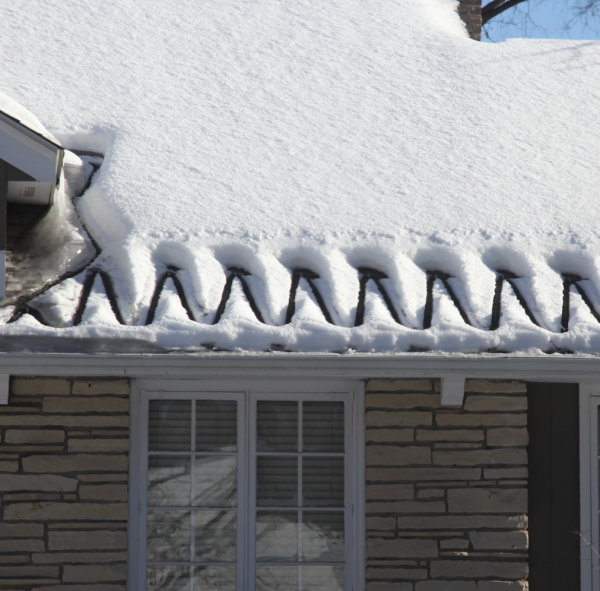
Roof deicing cable for ice dam prevention by the Ice Dam Company
Over the years we have heard people call heat cable many things.
Heat Coils for ice dam prevention:
Heat coils most likely get their name from the fact that the material itself, that is the heat cable, comes in coils and when installed by a hack is sometimes left in coils on the roof. Heat coils for ice dam prevention are of course the same thing as heat cables.
Roof deicing cables for ice dam prevention:
Roof deicing cables get their name from their primary purpose, to deice roofs. The name is a bit of a misnomer, however, because technically, roof deicing cables do not deice the entire roof, or even the majority of it. Ice dam deicing cables only melt channels through a small percentage of the ice dam to enable the passage of water through the ice dam so water is not able to back up behind the ice dam, into the roof material and into the home. Roof deicing cable is commonly used in the control of ice dams. Notice that there is a big distinction between preventing ice dams and controlling ice dams. Roof deicing wire and roof deicing cable is not meant to prevent ice dams so much as it is meant to control the affects of ice dams on roofs.
Gutter heat cables, Gutter heat tape and Gutter deicing cable:
Gutter heat tape also known as gutter heat wire, is used in the same fashion as heat cable, heat tape and roof deicing cable. It’s primary purpose is to melt ice, or more specifically, to prevent the original formation of ice in the gutter. As discussed in the here general section, gutters in fact have nothing to do with either the creation or severity of ice dams. This isn’t to say that using gutter heat tape or gutter heat wire is a bad idea. Having hundreds of pounds of ice form in your gutter system causes problems of its’ own, most notably that the gutters can be ripped off the house by the weight of the ice itself. Gutter heating coils is yet another variation of this category of names.
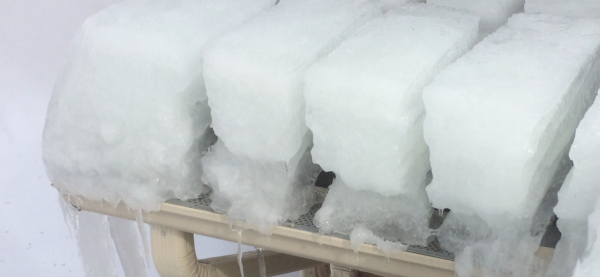
Gutter ice melting cable for ice dam prevention by The Ice Dam Company
Roof Heat Wire and Roof Heat Coils
As with other names, roof heat wire gets its’ name from the perception of its’ intended function. It’s just another way of saying heat cable or heat tape. Roof heat wire is wire on the roof that carries heat with the purpose of controlling ice dams or the damage created by ice formations on a roof.
Tags: gutter deicing wire, gutter heat coils, gutter heat wire, gutter heating cables, Heat cable, heat coils, heat tape for ice dams, heat wire for roof, heating coils for roof, ice dam heat cable, ice dam heat coil, Ice dam heat tape, ice dam prevention coils, ice dam prevention heat cable, roof deicing cable, roof deicing coils, roof deicing tape, roof deicing wire
Posted in Ice Dam Prevention, Ice Dams, Misc. | Comments Off on The Many Names of Ice Dam Heat Cable
Sunday, October 4th, 2015
HEAT CABLE CLIP COST:
CLICK HERE TO BUY ROOF CLIPS FOR SLATE ROOF HEAT CABLE INSTALLATION
$.78 to $1.22 Per Heat Cable Clip (Traditional, mechanically fastened clip used for standard asphalt roofs)
$25.00 to $35.00 Per Heat Cable Clip (Slotted clip used for slate, tile and cedar roofs)
$.78 to $1.22 Per Heat Cable Clip (Traditional, mechanically fastened clip)
We sell a wide variety of clips, brackets and doohickies for the installation of ice dam heat cable. There are three basic varieties of clips one can buy through the Ice Dam Company.
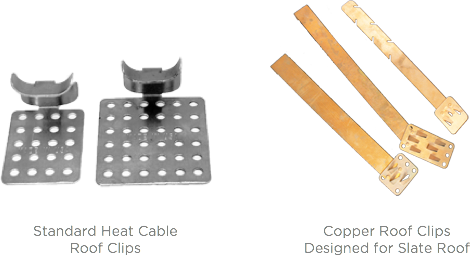
Roof clips for ice dam heat cables
Mechanically Fastened Heat Cable Clips:
This type of clip is either nailed or screwed onto the roof. It is by far the most common clip sold on The Ice Dam Company website and is used primarily to secure heat cables and roof deicing wire to asphalt roofs. Our installers use these clips to install ice dam heat cable by either nailing or screwing the clips directly to the roof surface, usually in conjunction with a blob of special polyurethane caulk. Once installed, these clips are used to hold the ice dam cable in place permanently without creating wear points that might eventually abrade through the cable and cause issues with functionality. The average cost of these heat cable and roof deicing wire clips for ice dam control is $.78 to $1.22 Per Heat Cable Clip, depending on style, color and order quantity.
Slotted Clips and Brackets for Heat Cable:
As the name suggests, this family of clips is slotted in order to allow installers to use existing fasteners on a roof system to hold the clip in place. The most common application is the slate roof clip or cedar roof clip. Such clips are slipped up, under the existing roofing material and hooked around the nails being used to hold the clip in place. Using slotted heat cable clips is the suggested method of installing heat cable and roof deicing cables on slate roofs and sometimes on cedar roofs because of the non-invasive, non-destructive nature of the install. Slotted roof heat cable and roof deicing clips are far more expensive for ice dam prevention installations than traditional heat cable clips. The average cost of these heat cable and roof deicing wire clips for ice dam control is $25.00 to $35.00 Per Heat Cable Clip, depending on style, color and order quantity. The vast majority of the slotted clips we sell are made of copper and are for use on slate roofs.
Glue-on clips for ice dam heat cable and roof deicing cable:
The third and final style of clips we sell are Glue-on clips. These clips are used on metal and single ply roofing systems, such are EPDM (rubber) and TPO membranes. Installing heat cable and roof deicing wire on metal roofs is not nearly as common as on other systems such as asphalt roofs and slate roofs. Metal roofs are simply less prone to ice dams, or more specifically, to damage caused by ice dams. Single ply systems, or roof membranes like TPO or rubber roofs, are even less likely to suffer from the ill consequences of ice dams. This explains why we sell less of this style of roof clip than any other. The average cost of these heat cable and roof deicing wire clips for ice dam control is $.92 to $4.55 Per Heat Cable Clip, depending on style, color and order quantity.
Tags: about ice dams, gutter deicing wire, gutter heat coils, gutter heating cables, heat cable clips, heat wire clips for slate, heating coils for roof, roof deicing coils, roof heat tape clips, slate roof clips for heat wire, slate roof ice dam cable
Posted in Ice Dam Prevention, Ice Dams, Misc. | Comments Off on Clips and Brackets for Heat Cable, Heat Tape and Deicing Coils
Wednesday, March 11th, 2015
As the oldest ice removal company in the USA, we get asked to do some pretty bizarre stuff. We have done our share of strange ice removal projects but one that keeps popping up is removing ice from around cooling towers. What is a cooling tower? I don’t know exactly but I suspect it has something to do with providing chilled air or water to industrial equipment inside buildings. We have removed ice from around industrial equipment, like cooling towers, for many years. The tricky part is that they are normally fed by high voltage and natural gas so you don’t want an inexperienced person attempting this work. We slice away ice from commercial and industrial equipment using the same equipment we use for removing ice dams from homes. That is, we use our modified commercial steamers. Our guys were under such pressure earlier this winter that they worked from 2pm around the clock to 7:30am. The operation of an entire plant depended on the cooling tower being operational. We used two crews to complete the task. It wasn’t a cheap job but the cost of one lost day of production was far worse. Plus, according to the commercial HVAC contractor consulting on the project, there was a good chance that the cooling tower could be seriously damaged if the ice was allowed to remain in place any longer than it was.
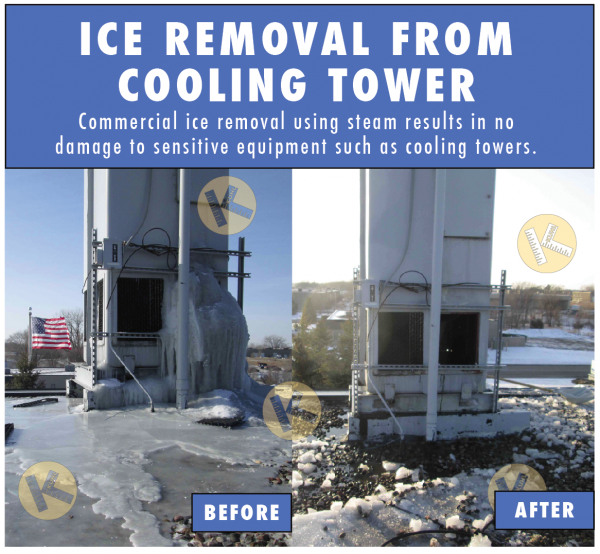
Industrial commercial ice removal contractor
Sometimes a crane is required to reach our work.
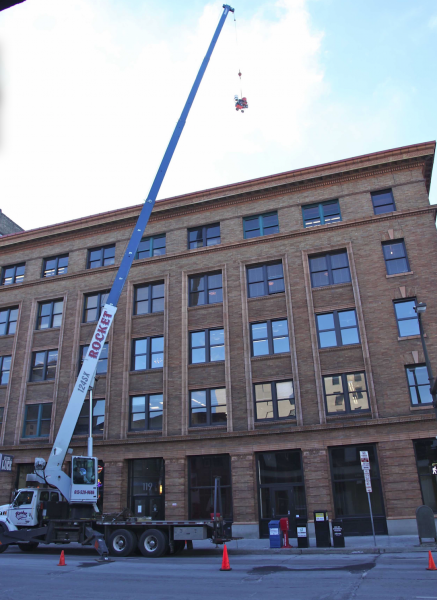
Commercial roof ice removal using steam
Tags: commercial ice removal, cooling tower ice removal, ice removal from HVAC equipment, industrial ice removal contractor, removing ice from commercial site
Posted in ice dam removal cost, Ice Dams, Misc., Ice Dams: General Info | Comments Off on How to Remove Ice from an Industrial Cooling Tower
Tuesday, March 3rd, 2015
We are often asked “How long will it take to remove my ice dams?”. While it may surprise you to hear this, after having removed thousands of ice dams, we still can’t give a definitive answer. Sure, most projects typically take somewhere between 2-6 hours, but that’s a big range. We ask that people send photos of their ice dams so that we can see what is happening. This helps us estimate costs to some degree. Specifically, these photos tell us approximately how long the ice dams are along an eave area. That is great. It’s also important to see what the site conditions are like. Is the job 8 feet or 28 feet off the ground? Will the chunks of ice we are removing fall harmlessly to the ground or is the ice dam located about a glass solarium that will need extensive protection? But even when we are armed with good photos there are still a number of variables that factor into the cost of removing an ice dam, the most important of which is what we call ‘depth’. The depth of an ice dam is the distance it travels up the roof. Study the diagram below. Notice call-out (A). This distance is in fact the most important factor in determining how long it takes to remove an ice dam (aside from it’s length, of course). Slicing through a 12″ thick ice dam is no big deal if it’s only 12″ deep. If it’s 24″ deep, that’s a totally different story.
The depth, or how far up the roof the ice has grown, is in fact the thing that drives the project time frame more than the thickness. The challenge is that if the ice dam is covered with snow, we can’t see how far up the roof the ice has grown. Only after we shovel the snow back can we get an accurate gauge as to how long the project will take.
Other variables that affect the duration of an ice dam removal job include: Height of work, site access and outdoor temperatures. Most people don’t know this but ice gets significantly harder to cut when it’s really cold out. The character of the ice actually changes and it takes longer to cut, even with the monster commercial steamers we use.
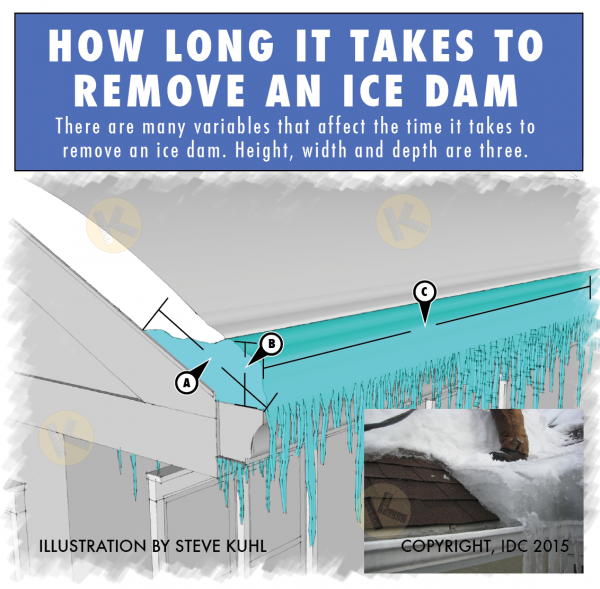
How long it takes to remove an ice dam.
Tags: cost estimate for ice dam removal, cost to remove ice dam, cost to remove ice dams, estimated time for ice dam removal using steam, how long does an ice dam take to steam off a roof?, how long does it take to remove ice dams
Posted in Ice Dam Removal, ice dam removal cost, Ice Dams, Misc. | Comments Off on How Long Should Ice Dam Removal Take?
Tuesday, February 24th, 2015

Where to buy ice dam steamer
I have been asked many, many times where we buy our equipment. A lot of people in my position would be nervous to reveal our key vendors, after all, providing such info might help our competition, right? I’m not hung up on helping others get into the business of ice dam removal. There is usually enough business to go around and, quite frankly, buying a steamer is just the first step. That said, it’s an important first step and to all who have asked me over the years, here is my answer. I buy our ice dam steaming equipment at American Pressure in Robinsdale, Minnesota. Click here to visit their site.
Here is another piece of advice I offer all who call. Buy more than one unit. It’s true, you will spend $4000-$5000 for a quality unit. But if there is an ice dam season, such an investment will pay for itself in a matter of days. Equipment redundancy is essential when you have clients calling because things can and do go wrong with ice dam steaming equipment. More often than not it is related to user error. For example, if even a single drop of water or small spec of ice gets into the fuel tank while refueling during a job, the machine will often shut down. User error. Or, if the ice dam steamer is using a water supply that is high in mineral content, those minerals will build up in the steel burner coil and in the high temp hoses, eventually shutting the machine down. Depending on the water supply and the number of hours the machine is running, it can take as little as a few days for this process to occur. The fix is simple (use powdered acid to ‘descale’ the machine and hoses). Nevertheless, it takes the machine out of circulation and when things are busy, it’s a huge bummer to not be steaming ice. I therefore always suggest buying more than one unit. I have yet to here of someone who regrets that decision.
I get calls from people all over the country and from Canada asking where to buy ice dam steaming equipment. American Pressure is my answer. Not only because they know their stuff but because they are truly good people at heart.
Tags: Ice dam steamer, ice dam steamer sales, ice dam steaming equipment, where can I buy an ice dam steamer?, where to buy ice dam steamers
Posted in Ice Dams, Misc. | Comments Off on Where to Buy Ice Dam Steamers
Friday, January 23rd, 2015
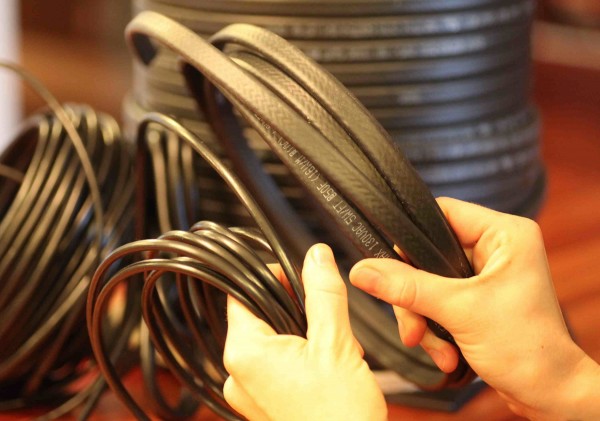
Heat cable reviews, Ice Dam Heat Cable Reviews
Heat cables manufactured by Easy Heat, Frost King and Wrap On are not worth buying. I can’t say it more plainly than that. These cables are typically sold at box stores like Home Depot and Lowes and they should be ashamed to sell them. Why? For starters, they are only warrantied for 1 or 2 years for a very good reason. That is as long as they last (I’ve attached warranties from Wrap On and Frost King below). Homeowners buy bad cables because they are cheap and because they believe what the packaging says. Sadly, we replace thousands of feet of this junk every year. We install more heat cables that any firm in the country and fully 20% of the work we do is the replacement failed ice dam heat cable systems manufactured by Easy Heat, Frost King and Wrap On.
Beyond the short lifespan, heat cables by Easy Heat, Frost King and Wrap On are energy hogs. While they only typically draw 5 watts a foot, they run at 100% while they are plugged in, regardless of the surrounding temperatures. They are what’s called ‘constant wattage’ cable. Our ice dam heat cables are self-regulating. They sense the outdoor temperatures and draw only the electricity they need to do the job. The net result is that cheap cables made by Easy Heat, Frost King and Wrap On chew through electricity. So, somewhat paradoxically, our heavy duty ice dam heat tape runs at over twice the peak wattage of the cheap stuff, it uses far less electricity over a season.
Don’t buy Big Box heat cable.
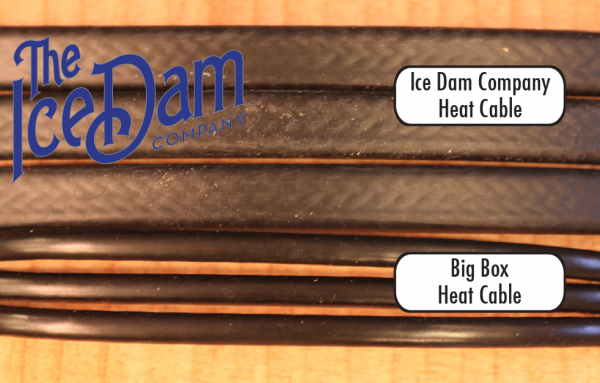
Which heat cables are best for ice dams?
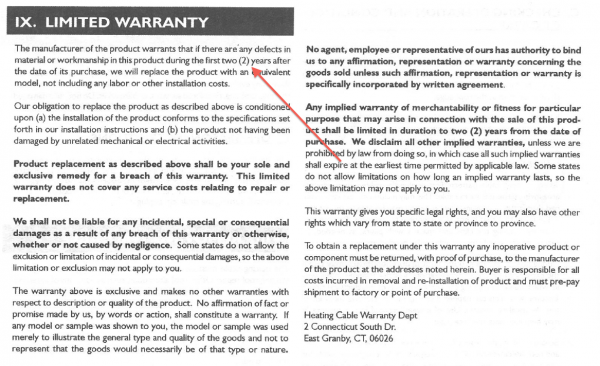
Heat tape made by Frost King, Easy Heat and Wrap On is worthless

Heat tape made by Frost King, Easy Heat and Wrap On is worthless
Tags: Easy Heat heat cables are terrible, frost king heat cable is worthless, Heat cable reviews, heat tape ice dam review results, heat tape reviews, home depot heat cable is crap, ice dam company heat cables for ice dams, which heat cables are best for ice dams, Wrap on heat cables are a scam
Posted in Ice Dam Prevention, Ice Dam Removal, Ice Dams, Misc., Ice Dams: General Info | Comments Off on Easy Heat , Frost King, Wrap On Ice Dam Heat Cable Scam
Thursday, January 22nd, 2015

Heat tape for ice dams, Electric gutter heating cables for sale
We get asked a lot about the difference between electric heat tape and electric heat cable. The answer is that there is no difference. Both descriptions apply to apply to a category of ice dam prevention cable that is run, usually in a zig-zag pattern, along the affected eaves of a home/building (See install info here). The height, or distance that pattern runs up the roof is determined by the depth of the over hang on the home. The deeper the overhang, the higher the pattern needs to travel.
Not all heat tape is created equal. Think about the difference between a Pinto and an Audi. Sure, they are both cars, but they are pretty different in terms of quality. Honesty alert: Some heat tape is absolute crap. It’s the stuff sold at big box stores under the names Easy Heat and Frost King, to name a few. It costs about 1/3 that of the heavy duty material we install every day. Guess what the difference in labor cost is to install crappy heat cable versus quality heat cable? Zero. It costs zero dollars more to install long-lasting, efficient ice dam heat tape than it does the cheap stuff. We replace thousands of feet of lousy ice dam heat tape every year in the Twin Cities market. Time and time again we see the cheap cables have failed because they have either burned out or have deteriorated due to normal UV exposure.
The moral of the story is please, don’t buy cheap ice dam prevention cable. It won’t last long and it costs far more to operate than quality cable.
Tags: cost for ice dam prevention heat tape, electric gutter heating cable, electric heat cable, electric heat tape for ice dams, ice dam heat cable, ice dam heat cable installer Minneapolis, Ice dam heat tape, ice dam heating cable installation, ice dam prevention tape, professional heat tape advice
Posted in Ice Dam Prevention, Ice Dams, Misc. | Comments Off on Heat Tape for Ice Dams
Wednesday, December 31st, 2014
In 2011, Ice Dam Company owner Steve Kuhl wrote a nationally published article about ice dams for the Journal of Light Construction. One of the topics that receieved the most attention was the notion that gutters have nothing to do with ice dams. Here is a deeper look at that assertion.
There is a great deal of confusion and misinformation about the relationship between gutters and ice dams. Many people are under the misconception that gutters cause ice dams or that gutters filled with ice can cause water to back up into homes. Neither is true. Nor do gutters amplify the negative effects of ice dams in terms of the likelihood or severity of leaks into a home.
We know that ice dams occure when:
1. Escaped heat from the inside of the home warms the roof deck.
2. This melts the snow on the roof, resulting in water that runs down to a cold, unheated area of the eave.
3. That water freezes, forming ice. After many cycles that ice piles up to form an ice dam.
Study the illustrations below. These are identical eave designs, one with gutters, the other without. The Area B in the diagrams below is referred to as the ‘cold edge’ of the eave because heat from the interior of the home doesn’t travel far enough to raise the temperatures above 32 degrees in this zone. Fact one: whether or not a home has gutters, the cold edge of the eave will still exist and this is where ice dams form. Fact two: leaks from ice dams occur in Area A, at the top edge of the ice dam where water–with nowhere else to go–is forced up under the roofing material and into the home. Another way to look at it is this. If the home in Figure 2 had bad leaks inside, those leaks would not be eliminated whatsoever if we took a chainsaw and cut off the gutters along the red dashed line (C). Gutters are irrelevant in the formation of ice dams. Gutters being full of debris is likewise irrelevant in terms of ice dams. End of story.
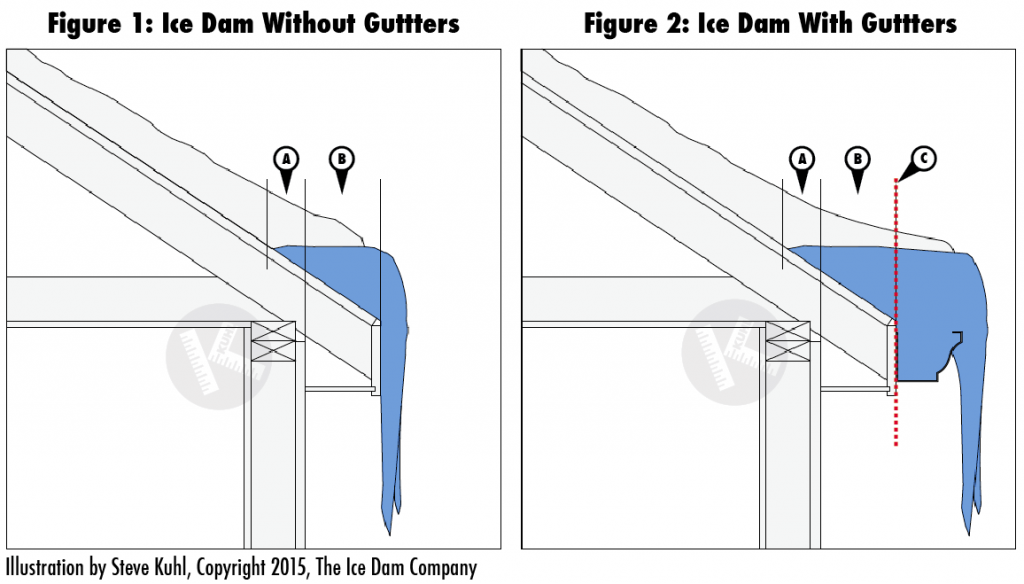
Ice in gutters fact vs fiction – Steve Kuhl, Ice Dam Expert explains
None of this is to suggest that ice in gutters is a harmless situation. We have seen many gutters damaged or destroyed by ice dams and that is a problem most homeowners would like to avoid. The point here is that all else held equal, if a home is likely to get ice dams the addition or deletion of gutters will be of no consequence to the formation or severity of said ice dams.
Ice dams can cause all sorts of damage. Below is a client of ours who had significant damage to her gutters and aluminum soffits from ice dams. Kuhl’s Contracting, our sister company, is one of the best companies in Minneapolis when it comes to repairing ice dam damage and ice dam prevention. Kuhl’s Contracting also installs more ice dam heat cables than any company in Minnesota. Of course, heat cables and heat tape are not a permanent solution for ice dams in Minnesota. Click here to see a Kuhl Case Study that examines one such approach to ice dam prevention using enhanced home insulation in Minneapolis. This particular ice dam prevention project was in Edina.

Ice dam damage to home repaired by kuhls contracting
Tags: do gutters cause ice dams, do gutters make ice dams worse, gutters and ice dams, heat cable prices, heat cable supplier, ice dam heat tape installer, kuhls contracting home insulation minneapolis, kuhls contracting ice dam prevention expert
Posted in Ice Dam Prevention, Ice Dam Removal, Ice Dams, Misc. | Comments Off on Ice Dams in Gutters – The Minneapolis Ice Dam Myth
Monday, December 22nd, 2014
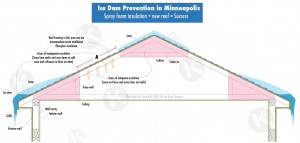
Attic insulation contractor addresses ice dams with new insulation in Edina
Using the words ‘ice dam prevention’ in Minneapolis is a dangerous gamble. It’s true that with certain efforts one can greatly reduce the chances of getting ice dams, it is almost impossible to prevent them altogether. For example, we can do a top quality insulation and ventilation retrofit on a Minneapolis attic only to be thwarted by the fact that the homeowner likes to keep the attic at 90 degrees in the winter. That is a formula for ice dam disaster in Minnesota. There are a number of methods to employ in preventing ice dams (or reducing their severity, in some cases). Here are links to two such approaches used by our sister company, Kuhl’s Contracting, a nationally recognized ice dam prevention company.
Approach to ice dam prevention in Minneapolis #1
Approach to ice dam prevention in Minneapolis #2
Homeowners looking to fix or at least minimize the risk of ice dams in Minnesota are wise to look at the key contributing factors that spawn ice dams. Those are, the weather, insulation, ventilation, air leaks, personal lifestyle and home architecture. We are frequently successful in reducing and/or eliminating ice dams through the use of high performance spray foam insulation systems in combination with enhanced attic ventilation.
Here is another helpful link on the topic of home insulation and ice dam prevention in Minneapolis
Tags: about ice dams, best ice dam removal in minneapolis, best rated ice dam removal contractor, commercial ice removal, construction site ice removal, edina ice dam removal, how to file an insurance claim for an ice dam, ice and snow removal, ice dam expert, ice dam removal jerks, Ice dam Steaming, ice removal company, ice removal from concrete, ice removal professionals, minneapolis ice dam removal, orono ice dam removal, roof ice steaming, signs of an ice dam problem, wayzata ice dam removal
Posted in Ice Dam Prevention, Ice Dams, Misc. | Comments Off on Minneapolis Ice Dam Prevention
Thursday, December 18th, 2014
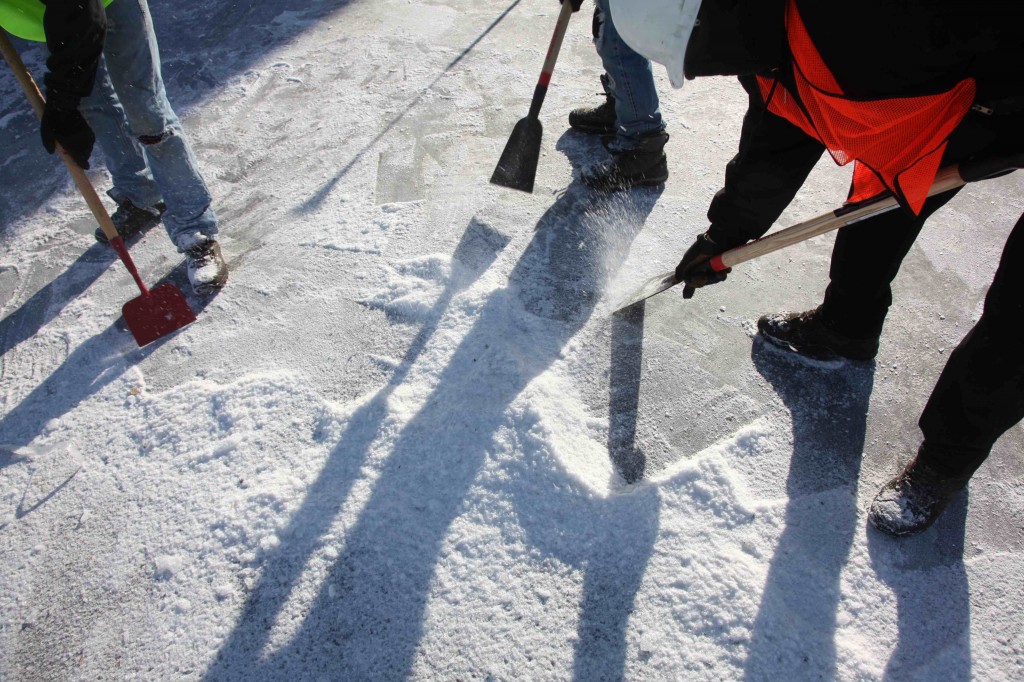
construction site ice removal, commercial ice removal, ice accumulation removal minneapolis, ice dam company
We have been called by property managers and builders to remove ice from a number of odd areas in Minneapolis over the years. Heck, we have even removed ice during the summer around cooling condensers at a chemical plant. While we frequently use our high-end steamers for the removal of ice, sometimes they are simply not appropriate. Such was the case on a recent job at a hotel under construction. A thin layer of ice had built up on the surface of a concrete floor that was perfectly flat…and huge. Using steamers in this application would have possibly resulted in making the problem worse by adding more water to the situation. While our steamers don’t generate much water, any time you melt ice, water is the result. Hence, my concern was that we would create a big mess. I suggested that we go old-school on this challenge. I sent three of my guys out there to hack and chip the ice with shiny, new scrapers. The resulting ice chips were simply blown and swept off the concrete, allowing the project carpenters to follow closely behind and lay out the wall framing without concern. It’s a low tech solution but sometimes that is what’s best.
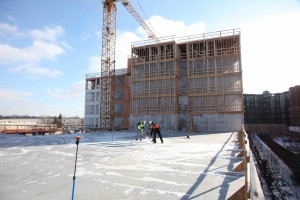
Ice removal minneapolis commercial ice removal from flat surface
Tags: about ice dams, best ice dam removal in minneapolis, best rated ice dam removal contractor, commercial ice removal, construction site ice removal, edina ice dam removal, how to file an insurance claim for an ice dam, ice and snow removal, ice dam expert, ice dam removal jerks, Ice dam Steaming, ice removal company, ice removal from concrete, ice removal professionals, minneapolis ice dam removal, orono ice dam removal, roof ice steaming, signs of an ice dam problem, wayzata ice dam removal
Posted in Ice Dams, Misc. | Comments Off on Commercial ice removal in Minneapolis






















